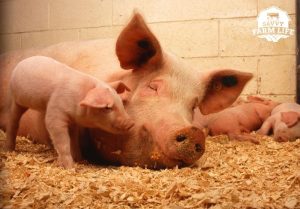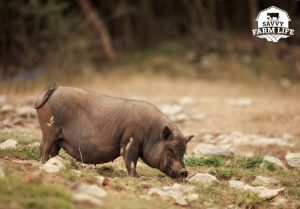
How Often Can Pigs Get Pregnant?
Pigs are known for their virility and ability to reproduce rapidly. Pigs are raised primarily for their meat, so most farmers who keep pigs choose to breed them for economic reasons. Most sows give birth easily, have large litters, and are fertile again shortly after weaning.
When can a pig get pregnant? Most female pigs reach sexual maturity by six months of age, though females should not be bred until their second or third heat. After puberty, they will go into heat every three weeks unless pregnant. Female pigs will show many signs of heat, including swelling of the reproductive organs and the standing reflex.
If you are planning to breed pigs in your herd, you will need to know when your female pig is old enough to reproduce, when she is fertile, and how many piglets she can produce. Read on to learn more about pig fertility and pregnancy.
The Female Pig Terminology
Before going further, we will need to clarify some pig terminology. You may come across the terms “gilt” and “sow” when discussing female pigs. What is the difference between the two? The term “gilt” is used to describe a female pig that has not been bred or is pregnant with her first litter. The term “sow” is used to describe a female pig that has produced at least one litter. A boar is a male pig. And, of course, a baby pig is called a piglet.
To learn more about female pigs, visit my article What a Female Pig is Called & Other Female Pig Facts.
At What Age Can A Pig Become Pregnant?
Most breeds of pigs become sexually mature at between 5 and 6 months of age. Some breeds reach puberty earlier than others, with the Meishan being the most precocious of them all – often reaching sexual maturity by three months of age. Like most mammals, however, just because a pig can become pregnant at this young age doesn’t mean that she should.
Most responsible breeders do not breed their gilts until they reach their second or even third estrus cycle for ethical and economic reasons. A 5-month old gilt does not necessarily have the level of maturity to raise offspring since she is still maturing herself. Pigs are intelligent creatures and need time to develop mentally, just as they need time to mature physically.
Several studies have also shown the average litter size if bred at the first heat, second heat, and third heat. On average, gilts that are bred during their first heat have significantly smaller litters than gilts bred for the first time during their second heat. During their third heat, gilts bred for the first time have even larger litters. These results are not limited to the first litter – gilts that are bred too early can suffer lifelong fertility issues, including smaller litters and even weaker litters. Many pig farmers wait until the second or third heat before breeding a gilt to get the most out of the pregnancy to maximize efficiency and profits.
As with any breeding program, it is essential to ensure that you use healthy parents with good conformation. One item to note regarding gilts is the health and number of teats. It would be best not to breed a gilt or sow unless the pig has at least 14 well-developed (i.e., not inverted) teats. If the pig has fewer than 14 functional teats, she may not feed all of her piglets.
How Often Do Pigs Come Into Heat?
The estrus cycle for a pig is a short one – pigs go into heat every 21 days (or every three weeks), and this period of fertility typically lasts between 8 and 36 hours. Since the gestation period for a pig is just shy of 4 months, this means that sows can easily produce two litters per year.
Most piglets wean naturally by about eight weeks of age, though pig farmers often wean their piglets around the 4-week mark. After weaning a litter, sows will again come into heat in as little as 4-7 days. With the frequent estrus cycle of the sow and the large litters produced, it is easy to see why pigs are such prolific breeders.
Signs Of Heat In Pigs
If you are unsure about your pig’s estrus cycle, there are a few signs that you can watch for that will tell you if she is in heat. If you intend to breed, it is crucial to become familiar with these signs to time the breeding correctly.
Swollen, Red Vulva
A gilt or sow will often present a visibly red and swollen vulva. This sign is more common with gilts and is not always apparent in older, mature sows. This swelling will often be one of the first signs, and a pig may not yet be fertile at the onset. If you notice swelling and redness, you may choose to wait 24 hours before attempting to breed.
Interest In Boars
If a gilt or sow is fertile, she will almost always show interest in a boar – this is one of the easiest ways to tell if she is ready to be bred. If you have your boar in a pen adjacent to your females, the pigs in heat will spend more time at the fence next to the boars – this is especially true if the boar is mature and odorous (the smellier, the better!). If a gilt or sow shows no interest in the boars, she is probably not yet ready to be bred.
The Standing Reflex
If you walk up to your female pig and press your hands firmly into her side or against her back, she will probably move away. She is probably in heat and ready to accept a boar if she does not move away and instead stands still against this pressure. Some pig keepers will actually attempt to sit on the female pig to see if she will move away – those that stand and allow themselves to be mounted are likely in heat. Those that run away… probably are not. I think the easier way to go about this is to press your hands onto her back. But if you are the adventurous sort, go ahead and hop on.
Once you’ve bred a pig, how do you tell if they’re pregnant? Check out my article, How To Tell If a Pig is Pregnant: Step-By-Step Guide, to get easy tips for determining if your pig is pregnant or not.
Reasons Your Pig May Not Become Pregnant
 If your gilt or sow has been bred but is not becoming pregnant, several factors can be causing infertility. The first is an illness – check your pig for signs of viral, bacterial, or parasitic infections. If your pig is unhealthy, her fertility health will suffer as well. Another factor to watch for is nutrition – if your pig’s diet is deficient in nutrients, she can have infertility.
If your gilt or sow has been bred but is not becoming pregnant, several factors can be causing infertility. The first is an illness – check your pig for signs of viral, bacterial, or parasitic infections. If your pig is unhealthy, her fertility health will suffer as well. Another factor to watch for is nutrition – if your pig’s diet is deficient in nutrients, she can have infertility.
If your pig is healthy and still not become pregnant, you may simply be timing the mating incorrectly. Remember, some of the signs of heat will be present the day before she comes into heat – so if you try to breed her at the first sign, you may be too early. Wait until she is receptive to the standing reflex and introduce her to the boar. Don’t be afraid to have her serviced more than once during standing heat – for the best chances of success, have them mate every 12 hours while they are in heat.
At What Age Can A Male Pig Be Bred?
The age at which a boar is bred is also crucial to the herd’s health, so make sure both your boar and your gilt are physically and mentally ready before they are bred. Boars (male pigs) will naturally mature differently than gilts. Boars can be used for breeding at six months but only for infrequent use. Boars have a significant impact on the quality of the litter, and if used regularly at too young an age, the litter will suffer.
By 7 or 8 months of age, boars can begin to be used for breeding more regularly – up to 2-4 times per week. By 12 months of age, boars are considered “mature” and can be used for 6-10 services per week.
Too many boars in a herd can cause problems within the group, and you only need one boar for every twenty females. When breeding your boar for the first time, use a small (and easy-going) sow or gilt – young boars need to gain confidence early in their breeding career, and a difficult sow can hinder future performance.
Timing Pig Pregnancy Is An Art
Pigs are incredibly fertile, and the pregnancy rates are highly successful compared to other mammals – pigs have up to a 77% fertility rate. While you may struggle to get the timing right at first, because the estrus cycle is so short, you won’t have to wait very long to give it another shot.
Preparing to breed your pigs and raise a litter comes with a financial commitment. To get a complete rundown of what it costs to raise pigs, visit my article How Much It Costs To Raise Pigs: Complete Expense Guide.
